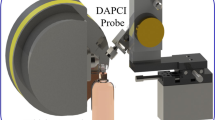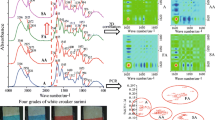Abstract
An analytical method for a rapid and nondestructive classification and authentication of whiskies of high commercial value based on trademark and years of aging is presented. Molecular absorption spectroscopy was performed with a minimum manipulation of the sample. Different conditions previous to the chemometric analysis, such as dilution and pH effect, were studied. Fifteen commercial trademarks of whiskies with different years of aging were acquired from the local market. The pattern recognition was performed using principal component analysis (PCA), linear discriminant analysis (LDA), and partial least square discriminant analysis (PLS-DA) to obtain models that allowed the classification and discrimination of whiskies based in trademarks and years of aging, respectively. Results show that by LDA, a mean of 99.15 % of samples was correctly classified according to trademark. On the other hand, by PLS-DA, a 100 % of correct classification and discrimination was achieved with several aging labels (6, 8, 12, and 15 years of aging).
Access this article
We’re sorry, something doesn't seem to be working properly.
Please try refreshing the page. If that doesn't work, please contact support so we can address the problem.




Similar content being viewed by others
References
Adams MJ (1995) Chemometrics in analytical spectroscopy. Analytical spectroscopy monographs. The Royal Society of Chemistry, Cambridge, p 216
Arvanitoyannis IS, Tzouros NE (2005) Implementation of quality control methods in conjunction with chemometrics toward authentication of dairy products. Crit Rev Food Sci Nutr 45:231–49
Ashok PC, Praveen BB, Dholakia K (2011) Near infrared spectroscopic analysis of single malt Scotch whisky on an optofluidic chip. Opt Express 19:22982–22992
Aylott RI, MacKenzie WM (2004) Analytical strategies to confirm scotch whisky authenticity. Part II: mobile brand authentication. Analyst (Cambridge, U K) 129:607–612
Aylott RI, MacKenzie WM (2010) Analytical strategies to confirm the generic authenticity of scotch whisky. J Inst Brew 116:215–229
Barker M, Rayens WS (2003) Partial least squares for discrimination. J Chemom 17:166–173
Bozkurt SS, Merdivan E, Benibol VY (2010) A fluorescent chemical sensor for ethanol determination in alcoholic beverages. Microchim Acta 168:141–145
Câmara JS, Marques JC, Perestrelo RM, Rogrigues F, Oliveira L, Andrade P, Caldeira M (2007) Comparative study of the whisky aroma profile based on headspace solid phase microextraction using different fibre coatings. J Chromatogr A 1150:198–207
Forina M, Lanteri S, Armanino C (1987) Chemometrics in food chemistry. In Topics in current chemistry. Berlin: Springer-Verlag Ed. pp 93–143
Gallignani M, Garrigues S, De la Guardia M (1993) Direct determination of ethanol in all types of alcoholic beverages by near-infrared derivative spectrometry. Analyst (Cambridge, U K) 118:1167–1173
González-Arjona D, Lòpez-Pérez G, González-Gallero V, González AG (2006) Supervised pattern recognition procedures for discrimination of whiskeys from gas chromatography/mass spectrometry congener analysis. J Agric Food Chem 54:1982–1989
Harrison BH, Priest FG (2009) Composition of peats used in the preparation of malt for Scotch whisky production—influence of geographical source and extraction depth. J Agric Food Chem 57:2385–2391
Heller M, Vitali L, Leal Oliveira MA, Costa ACO, Micke GA (2011) A rapid sample screening method for authenticity control of whiskey using capillary electrophoresis with online preconcentration. J Agric Food Chem 59:6882–6888
Hernandez OM, Fraga JMG, Jimenez AI, Jimenez F, Arias JJ (2005) Characterization of honey from the Canary Islands: determination of mineral content by atomic absorption spectrophotometry. Food Chem 93:449–58
Jack FR, Steele GM (2002) Modelling the sensory characteristics of Scotch whisky using neural networks—a novel tool for generic protection. Food Qual Prefer 13:163–172
Jackson M (2010) Malt whisky companion, 6th edn. Dorling Kindersley Ltd., London
Jones GR, Deakin AG, Spencer JW (2009a) Chromatic signatures of broadband optical spectra for liquor discrimination. Meas Sci Technol 20:025304
Jones GR, Deakin AG, Brookes RJ, Spencer JW (2009b) A portable liquor monitoring system using a PC-based chromatic technique. Meas Sci Technol 20:075305
Kemsley EK (1996) Discriminant analysis of high-dimensional data: a comparison of principal components analysis and partial least squares data reduction methods. Chemometr Intell Lab 33:47–61
Lachenmeier DW (2007) Rapid quality control of spirit drinks and beer using multivariate data analysis of Fourier transform infrared sepectra. Food Chem 101:825–832
Lee KYM, Paterson A, Piggott JR, Richardson GD (2001) Sensory discrimination of blended Scotch whiskies of different product categories. Food Qual Prefer 12:109–117
Luow L, Roux K, Tredoux A, Tomic O, Naes T, Nieuwoudt HH, van Rensburg P (2009) Characterization of selected South African young cultivar wines using FTMIR spectroscopy, gas chomatography and multivariate data analysis. J Agr Food Chem 57:2623–2632
McIntyre AC, Bilyk ML, Nordon A, Colquhoun G, Littlejohn D (2011) Detection of counterfeit Scotch whisky samples using mid-infrared spectrometry with an attenuated total reflectance probe incorporating polycrystalline silver halide fibres ns. Anal Chim Acta 690:228–233
Meites L (1982) Handbook of analytical chemistry, 1st edn. Mc Graw-Hill, New York, pp pp: 5–8
Mendes LS, Oliveira FCC, Suarez PAZ, Rubim JC (2003) Determination of ethanol in fuel ethanol and beverages by Fourier transform (FT)-near infrared and FT-Raman spectrometries. Anal Chim Acta 493:219–231
Mosedale JR, Puech JL (1998) Wood maturation of distilled beverages. Trends Food Sci Tech 9:95–101
Nagato L, Duran M, Caruso M, Barsotti R, Badolato E (2001) Monitoramento da autenticidade de amostras de bebidas alcohólicas enviadas ao instituto Adolfo Lutz en Sao Paulo. Cien Tec Alimen 21:54–62
Nordon A, Mills A, Burn RT, Cusick FM, Littlejohn D (2005) Comparison of noninvasive NIR and Raman spectrometries for determination of alcohol content of spirits. Anal Chim Acta 548:148–158
Novakowski W, Bertotti M, Paixão TRLC (2011) Use of copper and gold electrodes as sensitive elements for fabrication of an electronic tongue: discrimination of wines and whiskies. Microchem J 99:145–151
Otto M (1999) Chemometrics, statistics and computer. Application in analytical chemistry, 1st edn. Wiley-VCH, Weinheim, pp pp. 41–47
Sharma S (1996) Applied multivariate techniques, 1st edn. Wiley, New York, pp p 1–15, 59-66, 264-267, 287-293
Sperková J, Suchánek M (2005) Multivariate classification of wines from different Bohemian regions (Czech Republic). Food Chem 93:659–663
The Scotch Whisky Association (2011) URL http://www.scotch-whisky.org.uk/swa/files/halfyearexpors2011final.pdf. Accessed 01.11.13
The Scotch whisky Regulations (2009) UK Government, 2009. URL http://www.legislation.gov.uk/uksi/2009/2890/pdfs/uksi20092890.pdf Accessed 01.11.13
Tipparat P, Lapanantnoppakhlun S, Jakmunee J, Grudpan K (2001) Determination of ethanol in liquor by near-infrared spectrophotometry with flow injection. Talanta 53:1199–1204
Tòthovà J, Ziak L, Sàdeckà J (2008) Characterization and classification of distilled drinks using total luminescence and synchronous fluorescence spectroscopy. Acta Chim Slov 1:265–275
Urbano M, Luque de Castro MD, Pérez PM, Gómez-Nieto MA (2005) Study of spectral analytical data using fingerprint and scaled similarity measurements. Anal Bioanal Chem 381:953–963
Vandeginste BGM, Massart D L, Buydens LMC, Jong SDE, Lewi PJ, Smeyers-Verbeke J. (1998) Chapter 31. Analysis of measurement tables. Chapter 33. Supervised pattern recognition. In Handbook of Chemometrics and Qualimetrics: Part B; Elsevier: Amsterdam, The Netherlands. pp 87–158, 207–223
Wang LC, Tang KT, Chiu SW, Yang SR, Kuo CT (2011) A bio-inspired two-layer multiple-walled carbon nanotube-polymer composite sensor array and a bioinspired fast-adaptive readout circuit for a portable electronic nose. Biosens Bioelectron 26:4301–4307
Wold S, Esbensen K, Geladi P (1987) Principal component analysis. Chemom Intell Lab Syst 2:37–52
Wold S, Sjostroma M, Eriksson L (2001) PLS-regression: a basic tool of chemometrics. Chemom Intell Lab Syst 58:109–130
Acknowledgements
The authors wish to thank the financial support from Univ. Nacional de San Luis, Univ. Nacional de La Pampa, and Consejo Nacional de Investigaciones Científicas y Técnicas (CONICET). Also, we want to thank Prof. Roberto Olsina (Univ. Nacional de San Luis) for providing The Unscrambler 6.11 software; and Facultad de Agronomía, Univ. Nacional de La Pampa, for providing the InfoStat software.
Conflict of Interest
Miguel Ángel Cantarelli declares that he has no conflict of interest. Silvana Mariela Azcarate declares that she has no conflict of interest. Marianela Savio declares that she has no conflict of interest. Eduardo Jorge Marchevsky declares that he has no conflict of interest. José Manuel Camiña declares that he has no conflict of interest. This article does not contain any studies with human or animal subjects.
Author information
Authors and Affiliations
Corresponding author
Rights and permissions
About this article
Cite this article
Cantarelli, M.Á., Azcarate, S.M., Savio, M. et al. Authentication and Discrimination of Whiskies of High Commercial Value by Pattern Recognition. Food Anal. Methods 8, 790–798 (2015). https://doi.org/10.1007/s12161-014-9958-8
Received:
Accepted:
Published:
Issue Date:
DOI: https://doi.org/10.1007/s12161-014-9958-8




